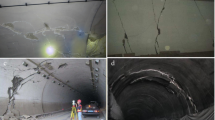Abstract
Mountain tunnels, being underground structures and situated deep within rock layers, are generally considered to suffer appreciably less damage from earthquakes than surface structures. However, it has been reported that many tunnels were damaged by the 1923 Great Kantou earthquake, the 1995 Great Hanshin Earthquake, the 1999 Taiwan Chi-Chi Earthquake, the 2004 Mid Niigata Prefecture Earthquake and the May 2008 Great Wenchuan Earthquake in China. In this study, the damaged tunnels resulted of the 2004 Mid Niigata Prefecture Earthquake are the study objects. The damage patterns are analyzed, and the information which is considered to be of influence, such as the distance to epicenter, the completion time, the geological conditions, etc., are collected. A database of the damaged tunnels has been created using a Geographic Information System (GIS). The influence ranking for these factors has been analyzed using Hayashi’s quantification theory II. The degree of the tunnel damage has also been assessed using GIS and Hayashi’s quantification theory II. The field investigation is in close agreement with the assessment results following Hayashi’s quantification theory II.










Similar content being viewed by others
References
Asakura T, Sato Y (1998) Mountain tunnels damage in the 1995 Hyogoken-nanbu Earthquake. Q Rep RTRI (Railway Technical Research Institute) 39(1):9–16
Dowding CH, Rozen A (1978) Damage to rock tunnels from earthquake shaking. J Geotech Eng Div, ASCE 104(2):175–191
ESRI (2001) Exploring ArcObjects. ESRI Press, Redlands
Hashash YMA, Hook JJ, Schmidt B, Yao JIC (2001) Seismic design and analysis of underground structures. Tunn Undergr Space Technol 16:247–293
Hayashi C (1954) Multidimensional quantification II. Proc Jpn Acad 30(3):165–169
Hayashi C (1974) Methods of quantification. Toyo Keizai Shinpo Publishing Co., Tokyo
Japan Meteorological Agency (JMA) (2004) Monthly report on earthquakes and volcanoes in Japan October 2004. (http://www.seisvol.kishou.go.jp/eq/gaikyo/monthly200410.pdf)
Jiang Y, Honda Y, Wang C, Tanabashi Y (2008a) Study about the identification of the damage influence category of the suffering tunnel structure by the earthquake. Proceedings of the 43th JNCGE Hiroshima’08, JGS, (CD-ROM) (In Japanese)
Jiang Y, Wang C, Honda Y (2008b) Study on damage analysis of tunnels caused by earthquake using GIS and quantification theory II. Journal of Geotechnical Engineering, JSCE (In Japanese)
Kawakami H (1984) Evaluation of deformation of tunnel structure due to Izu-oshima-kinkai earthquake of 1978. Earthquake Eng Struct Dynam 12:369–383
Konagai K, Takatsu S, Kanai T, Fujita T, Ikeda T, Johansson J (2008) Kizawa tunnel cracked on 23 October 2004 Mid-Niigata earthquake: an example of earthquake-induced damage to tunnels in active-folding zones. Soil Dyn Earthquake Eng. doi:10.1016/j.soildyn.2008.04.002
Lin CCJ, Chai JF (2008) Reconnaissance report on the China Wenchuan earthquake May 12. NCREE Newsletter 3(3):1–5
Nakata T, Imaizumi T (2002) Digital active fault map of Japan. University of Tokyo Press, 60 p, DVD-ROM
Okamoto S (1973) Introduction to earthquake engineering. University of Tokyo Press, Tokyo, pp 29–40
Saito T, Mukouyama M, Taguchi Y (2007) Damages to railroad tunnels in the Niigataken Chuetsu-oki Earthquake Shinetsu line Yoneyama to kashiwazaki. Tunn Undergr 38(12):891–900
Sharma S, Judd WR (1991) Underground opening damage from earthquakes. Eng Geol 30:263–276
Shimizu M, Kurisu M, Katou S (2005) Damages of railway tunnels by Niigata Chuetsu earthquake. Tunn Undergr 36(5):421–428 (In Japanese)
Shimizu M, Saito T, Suzuki S, Asakura T (2007) Results of survey regarding damages of railroad tunnels caused by the Mid Niigata Prefecture Earthquake in 2004. Tunn Undergr 38(4):265–273
Tunnel Engineering Committee, JSCE (2005) Report of the 2004 Mid Niigata Prefecture Earthquake. JSCE (In Japanese)
Tunnel Engineering Committee, JSCE (2008) Report of the 2007 Niigata Prefecture Chuetsu Offshore Earthquake. JSCE (In Japanese)
Wang WL, Wang TT, Su JJ, Lin CH, Seng CR, Huang TH (2001) Assessment of damage in mountain tunnels due to the Taiwan Chi-Chi Earthquake. Tunn Undergr Space Technol 16:133–150
Yashiro K, Kojima Y (2007) Historical earthquake damage to tunnels in Japan and case studies of railway tunnels in the 2004 Niigataken-Chuetsu Earthquake. QR of RTRI 48(3):136–141
Yoshikawa K (1981) Investigation about past earthquake disasters of railway tunnels. Q Rep RTRI (Railway Technical Research Institute) 22(3):103–111
Acknowledgments
This research is partly sponsored by the National Natural Science Foundation of China (No. 50874021). The authors are also grateful to the reviewers for their useful comments and suggestions that have substantially improved this paper.
Author information
Authors and Affiliations
Corresponding author
Rights and permissions
About this article
Cite this article
Jiang, Y., Wang, C. & Zhao, X. Damage assessment of tunnels caused by the 2004 Mid Niigata Prefecture Earthquake using Hayashi’s quantification theory type II. Nat Hazards 53, 425–441 (2010). https://doi.org/10.1007/s11069-009-9441-9
Received:
Accepted:
Published:
Issue Date:
DOI: https://doi.org/10.1007/s11069-009-9441-9




